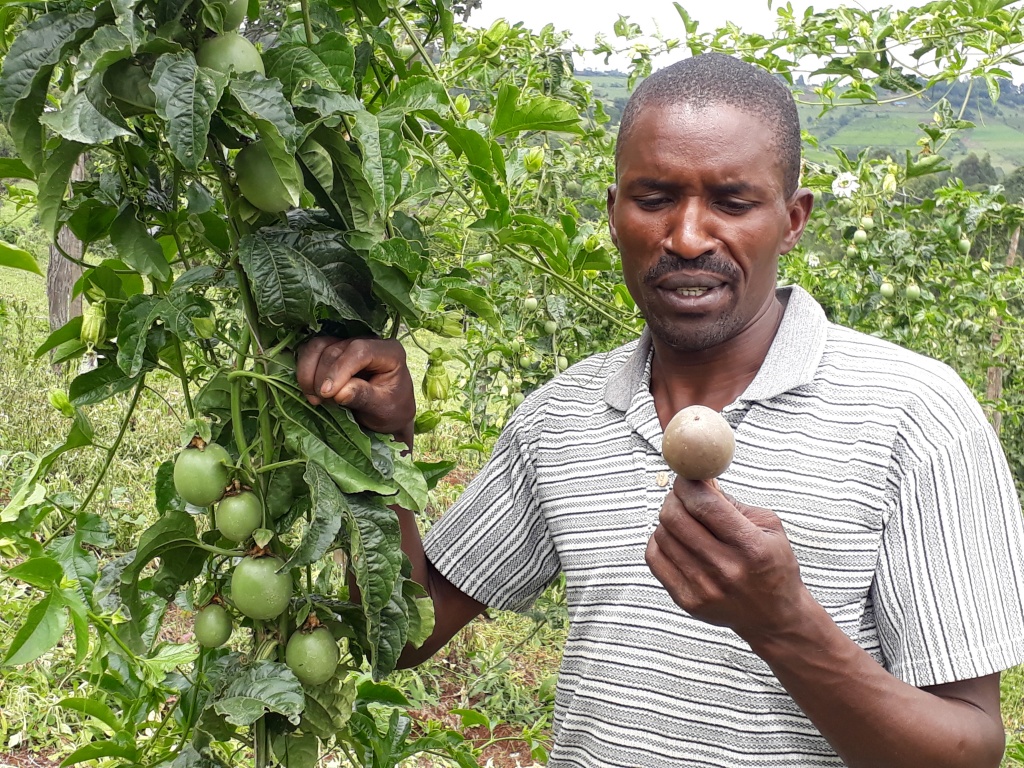
Elijah Langat , passion fruit farmer.
Despite Kenya’s potential to grow and export passion fruits, production of the highly profitable crop has been on the decline over the past decade with no exports going into the European Union. Kenya produced and exported the fruits in the 90s and early 2000 but since 2003, decline in production started because of pest management challenges among other reasons.
The Fresh Produce Exporters Association of Kenya Chairman Apollo Owuor told a gathering of farmers, buyers and development partners at a conference titled Making Kenya the Global Leader in Passion Fruit Production and Marketing held in Eldoret last month.
RELATED STORY: Shortage sparks passion fruit price rise
The European market has strict guidelines on pesticides residues and passion was reported to contain above allowable limits.
He added there has not been efforts to revive the industry partly because passion is listed by the Ministry of Agriculture as a minor horticultural crop therefore not in government policy for priority. The Agriculture Food Authority Horticulture Directorate head Zakayo Magara admitted passion fruit is listed under 100 other minor crops.
Following the day-long deliberations, the Council of Governors Agriculture Committee, represented by Anne Koech, County Executive Committee Member in charge of Agriculture, Kericho, made a commitment to propose and support the upgrading of the crop to a major so that funds can be allocated to development of passion in counties earmarked as suitable to grow it. She said the county governments would subsidise purchasing of seedlings to improve production and create market linkages to streamline marketing among in Western region, considered as a high potential passion fruit production zone.
RELATED STORY: Purple passion fruit market pops up in Kiambu County
According to the United States Agency for International Development (USAID) that funded the conference through the Kenya Agriculture Value Chains Enterprises (Kaves), Passion fruits can grow anywhere in Kenya due to availability of varieties for warmer and colder parts of the country. “We have yellow passion for the lower, warmer regions and the more common purple variety for the higher cooler parts,” said Dr Steve New, Kaves Chief of Party. He added there is potential for Kenya to be a world leader in tropical juice production due to year-round availability of tropical fruits – passion, mango and pineapple, as the only country in the world that can grow the crops continuously.
Passion fruit is the most profitable in comparison with other crops, according to the Passion Fruit Value Chain Study undertaken in 2015 by Dr Hezekiah Agwara which indicates a farmer can make good income from a small parcel of land measuring 0.3- 0.6 of an acre. Dr New describes this as “poverty level minimum” that can sustain a livelihood. He added nothing goes to waste from a passion fruit plant. “Minimal wastage in passion fruit production because there is a huge domestic market. Passion is also used by processors for juice while neighbouring Uganda is a big market for Kenya passion fruits taking 50 per cent of total production. South Sudan is also buying lots of passion from Kenya.
RELATED STORY: Passion opens international markets for farmer association
Dr New stresses that passion fruit is best produced by smallholders due the attention it requires for maximum productivity. At spraying the plant will be at different stages of pest control making it hard for largescale management. On one vine you can have a flower, a young and mature fruit at the same time. The disease and pest control for each is different and non should affect the other, especially the ready to harvest fruit which shouldn’t have traces of chemicals. Managing this balance it not easy, he said.
According to Eric Ogumo, UK retail giant, Tescos, manager for Africa, passion fruit is the most sought after in their shelves in Europe, retailing at Ksh 2,000 a kilo. “Buyers always ask for Kenya fruits but there are none. “We are here to buy your fruits”, he told an attentive gathering. Mr Ogumo said they are buying from Southern Africa countries of South Africa, Zimbabwe and Zambia. “There is a ready market if we can get your fruits”, he said adding that Kenya is not benefiting from newest varieties because the country is not exporting. “There are newer, better yielding, pest and diseases resistant varieties for export but they are not being grown here.” Mr Ogumo said.
RELATED STORY: Yellow passion fruit doubles fruit farmers incomes
The biggest challenge of meeting pesticides residue limits is caused by there being only one registered product. The Agriculture Committee of the Council of Governors has committed to bring agrochemical firms together with the Ministry of Agriculture and the Pest Control Products Board to discuss extension of labels to include passion fruits in pest control products available in the country to give farmers options.
Biological control products firms have also not conducted research on the passion due to its minor crop status.
Write comment (0 Comments)

















